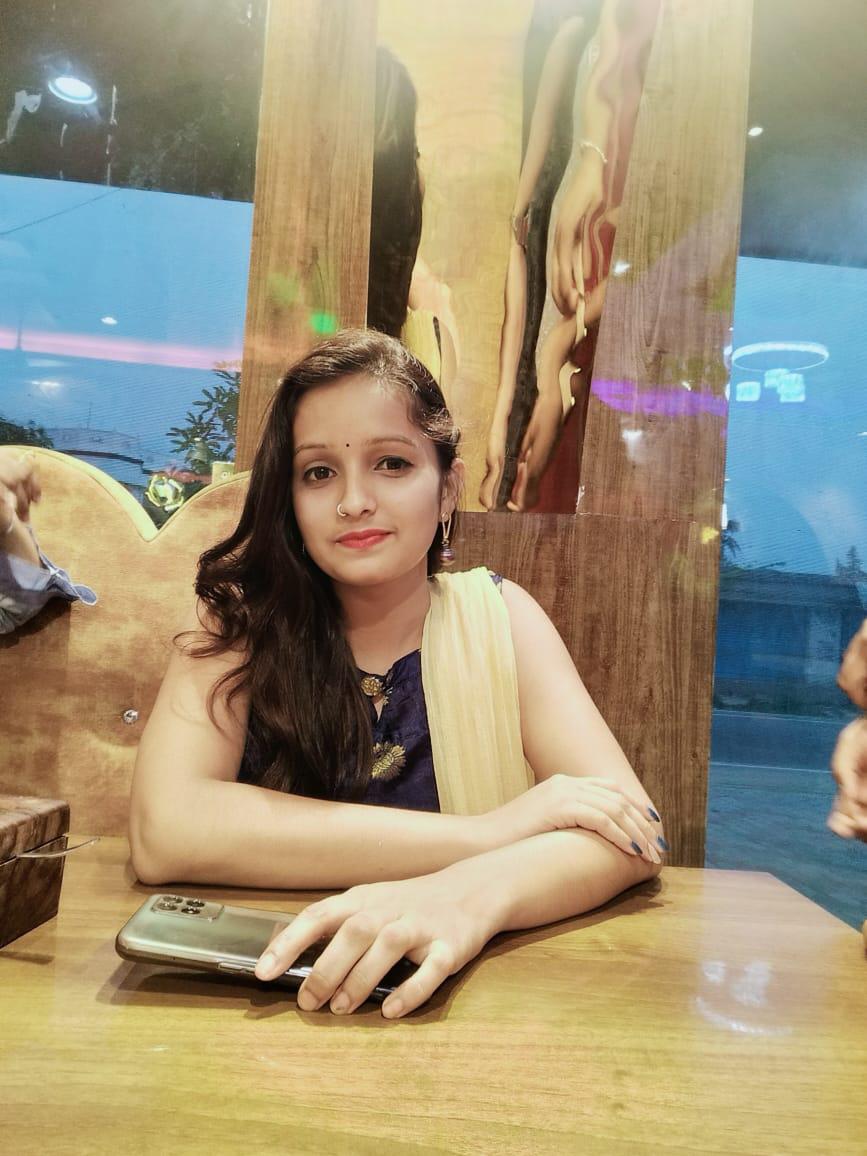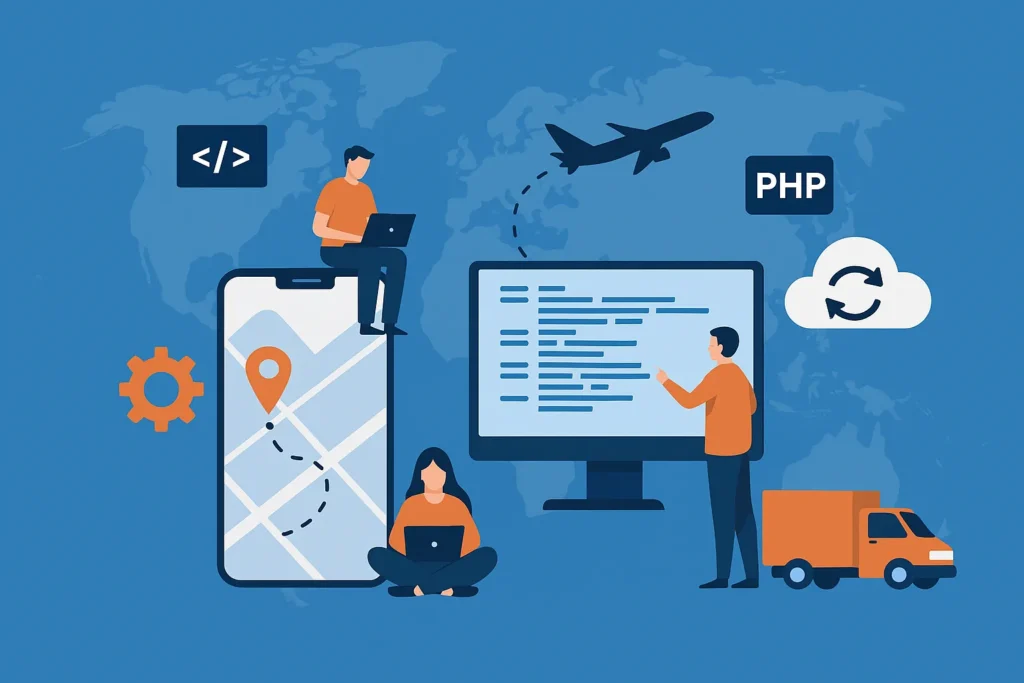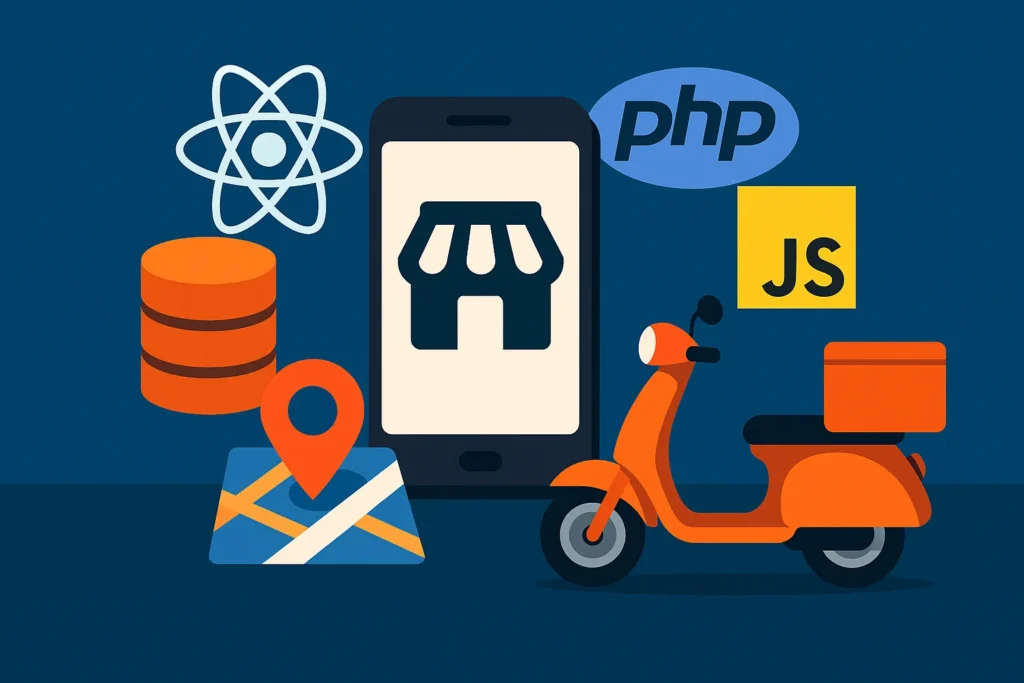In today’s fast-paced world, food delivery apps like Seamless have revolutionized the way people order food. Whether you’re craving a quick snack or a full meal, apps like Seamless connect users to local restaurants, offering a seamless experience from order placement to doorstep delivery. The convenience, user-friendly interface, and efficient delivery have made Seamless one of the leading food delivery platforms in the market.
But what if you could build an app like Seamless for your own business? With the right technology, features, and strategy, creating a food delivery app that rivals Seamless is entirely achievable. This guide will walk you through everything you need to know, from essential features and tech stack to development costs, helping you bring your food delivery app idea to life.
Whether you’re an entrepreneur or a business looking to expand, developing a food delivery app can open new revenue streams and tap into the growing demand for on-demand services. Partnering with Miracuves Solutions, a leader in app development, can ensure your project is built efficiently, with top-tier expertise and full-cycle support from start to finish.
What is Seamless and What Does It Do?
Seamless is a popular food delivery platform that simplifies the process of ordering food from a wide variety of local restaurants. With just a few taps, users can browse restaurant menus, place their orders, and track their delivery in real-time—all from the comfort of their mobile device. What makes Seamless stand out is its user-friendly interface, which is designed to offer a smooth, hassle-free experience from start to finish.
Founded with the aim of bridging the gap between hungry customers and local eateries, Seamless has grown into a trusted name in the food delivery industry. It offers a comprehensive solution, handling everything from displaying restaurant menus to processing payments and coordinating deliveries. The app connects three key users: customers, restaurants, and delivery personnel. Each group benefits from its streamlined design and functionality, ensuring that orders are processed efficiently.
For restaurants, Seamless provides a platform to reach more customers without the need for them to manage their own delivery logistics. Delivery personnel can accept and track orders with ease, helping them make timely deliveries, while customers can enjoy their meals without leaving their homes or offices. It’s this “seamless” connection between all parties that has driven the app’s success.
Why Build an App Like Seamless?
The food delivery market has experienced explosive growth in recent years, driven by the increasing demand for convenience and the shift toward online ordering. Apps like Seamless have tapped into this demand by providing an easy way for customers to order from their favorite restaurants without stepping out. As more people turn to their phones to meet daily needs, building a food delivery app like Seamless is not just a business idea—it’s a gateway to entering a lucrative and fast-growing market.
For businesses, creating a Seamless-like app offers multiple benefits. First, it expands the customer base by giving restaurants an online presence without the need for them to invest in their own delivery system. This allows restaurants to focus on what they do best—preparing delicious food—while your platform handles logistics, payments, and deliveries. Additionally, such an app provides valuable insights into customer preferences and behaviors, enabling better marketing strategies and personalized offerings.
From a business perspective, food delivery apps also offer strong revenue potential. With commission fees, delivery charges, and subscription models, you can generate steady income. By building a platform like Seamless, you’ll not only meet the growing demand but also position yourself at the forefront of a booming industry with vast opportunities for scaling and growth.
How to Differentiate Your App from Competitors
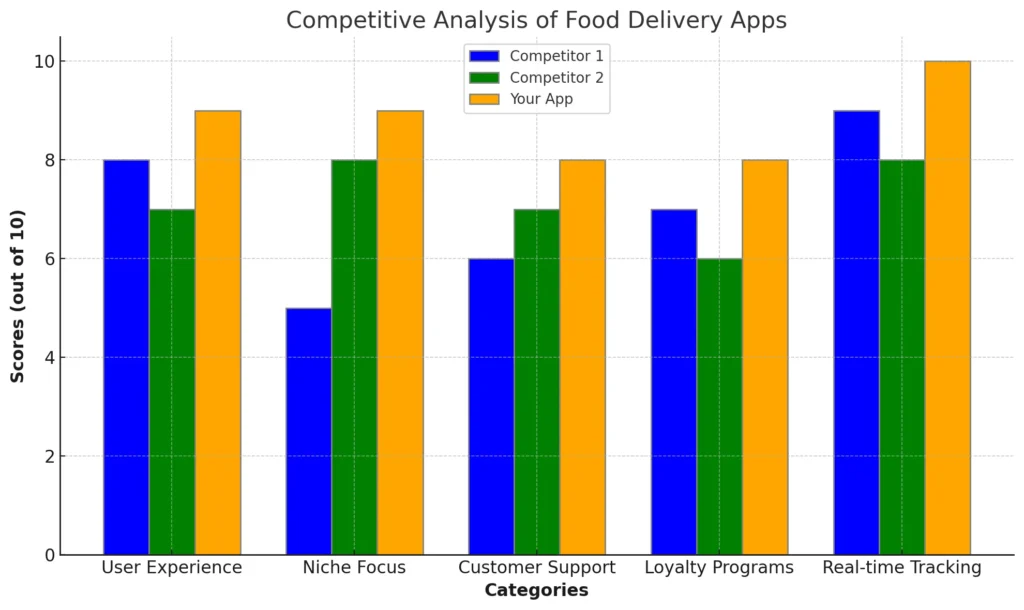
Building a food delivery app like Seamless is an exciting venture, but to succeed in a crowded market, differentiation is key. There are numerous food delivery platforms available today, so what will make your app stand out? The answer lies in innovation and providing features that cater to niche audiences or solve pain points better than existing solutions.
One approach to setting your app apart is focusing on a specific niche. For example, you could create a platform that specializes in local cuisine, healthy meal options, or even eco-friendly deliveries. By narrowing your target audience, you can attract a loyal customer base that values specialized offerings rather than generalized services.
Another way to differentiate your app is by improving the user experience. Seamless provides a great ordering process, but there is always room for improvement. Consider offering features like real-time order customization, AI-powered recommendations, or a loyalty program that rewards frequent users. Adding elements like personalized deals or instant reordering options can also boost customer engagement.
Additionally, customer support plays a huge role in retention. Offering 24/7 live chat assistance or providing real-time updates on delivery issues can create a stronger sense of trust and reliability among users.
By focusing on a unique angle, improving user experience, and investing in superior customer service, your app can stand out in the competitive food delivery market.
Read More “How to Build an App Like Menulog: Design, Features, and Cost Breakdown“
Market Size, Growth, and Business Model
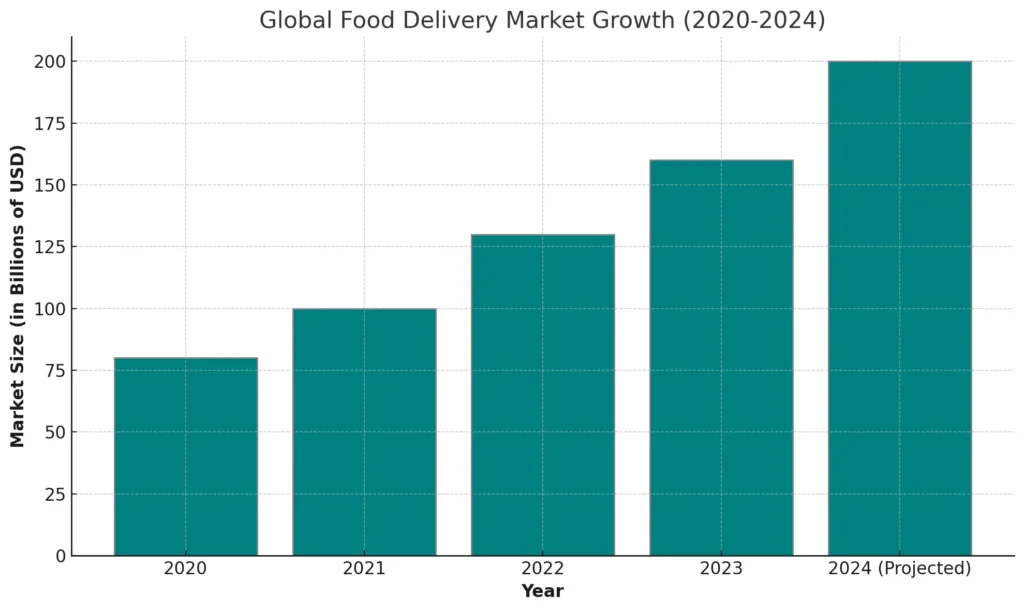
The food delivery industry is experiencing rapid growth, with millions of users opting for on-demand meal services every day. As of 2024, the global online food delivery market is projected to reach billions of dollars in revenue, driven by the increasing demand for convenience, a rise in smartphone usage, and evolving consumer habits. This trend shows no signs of slowing down, with double-digit growth rates predicted over the next several years.
The key to tapping into this booming market is understanding the different business models that power food delivery platforms. Apps like Seamless typically rely on multiple revenue streams, such as commission fees from restaurants, delivery charges, and subscription models. These models ensure a steady income while providing value to both customers and restaurants. Many apps are also experimenting with premium memberships, which offer perks like free delivery or exclusive deals, adding another layer of monetization.
With the market expanding and consumer preferences shifting toward convenience, building a food delivery app like Seamless positions you at the forefront of this thriving industry. By leveraging the right business model and scaling your services, you can capture a share of this ever-growing market.
Key Features of an App Like Seamless
| User Type | Core Features |
|---|---|
| Customers | – User Profiles (addresses, payment methods, order history) |
| – Restaurant Listings and Menus (with ratings, reviews) | |
| – Real-Time Order Tracking | |
| – Multiple Payment Options (credit cards, digital wallets, cash on delivery) | |
| Restaurants | – Restaurant Dashboard (manage orders, menus, track deliveries) |
| – Order Notifications (instant notifications for new orders) | |
| – Sales Analytics (track sales, popular items, and peak hours) | |
| Delivery Personnel | – GPS Integration (real-time navigation for faster deliveries) |
| – Order Management (ability to accept/reject orders based on proximity and schedule) |
Building an app like Seamless requires careful planning around key features that ensure a smooth, user-friendly experience for all parties involved—customers, restaurants, and delivery personnel. These features not only enhance functionality but also determine the overall success of your app.
Core Features for Customers:
- User Profiles: Customers should have personalized accounts where they can store their delivery addresses, payment methods, and order history for convenience.
- Restaurant Listings and Menus: A comprehensive list of restaurants, complete with menus, ratings, and reviews, helps users make informed choices.
- Order Tracking: Real-time tracking of orders gives customers peace of mind, allowing them to see when their food will arrive.
- Multiple Payment Options: Offering various payment methods, including credit cards, digital wallets, and cash on delivery, is essential for customer satisfaction.
Core Features for Restaurants:
- Restaurant Dashboard: A user-friendly dashboard where restaurants can manage orders, update menus, and track deliveries.
- Order Notifications: Instant notifications to ensure that restaurants can process orders quickly.
- Analytics: Data insights on sales, popular items, and peak hours help restaurants optimize their operations.
Core Features for Delivery Personnel:
- GPS Integration: Real-time GPS navigation helps delivery drivers find the quickest routes to customers’ locations.
- Order Management: A feature allowing drivers to accept or reject orders based on proximity and schedule.
In addition to these essential features, you can consider adding loyalty programs, in-app customer support via chat, and AI-based recommendations to further enhance user engagement and retention.
Minimum Viable Product (MVP) Approach
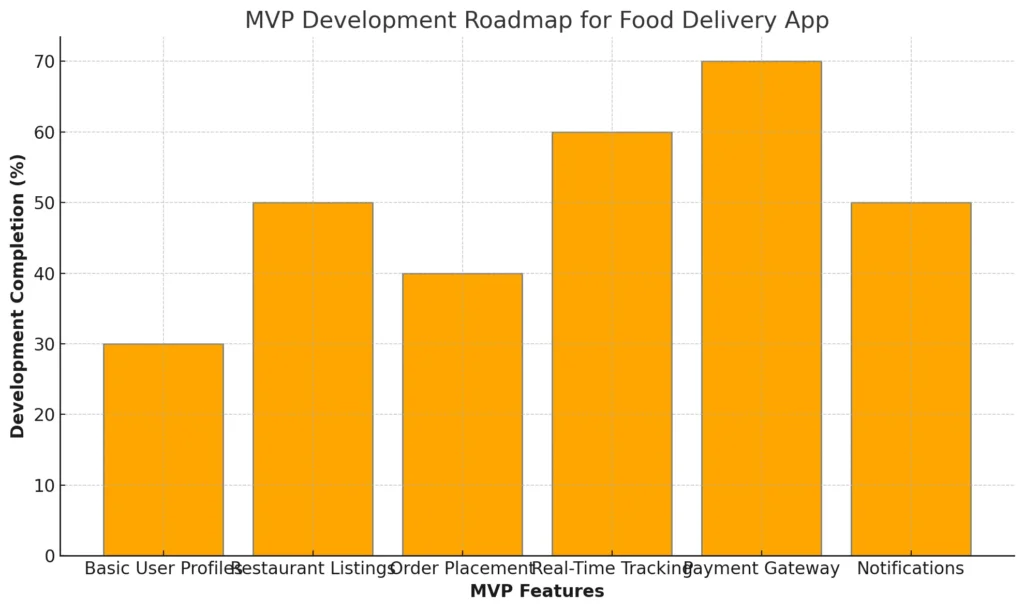
When building a food delivery app like Seamless, it’s important to start small and scale over time. This is where the concept of a Minimum Viable Product (MVP) comes in. An MVP allows you to develop and launch the core functionalities of your app with minimal investment, gather user feedback, and then iterate based on real-world use. It’s a smart, cost-effective way to test your idea in the market without overcommitting resources.
MVP Features to Consider:
- Basic User Profiles: Allow customers to create accounts and save essential details like delivery addresses and payment methods.
- Restaurant Listings and Menus: Feature a select number of restaurants, showcasing their menus and pricing to give users enough variety to start.
- Order Placement: Enable customers to easily place orders, customize their meals, and choose between pick-up or delivery options.
- Real-Time Tracking: Implement basic GPS functionality so users can track their orders once placed.
- Payment Gateway: Include multiple payment options like credit cards, digital wallets, and cash on delivery to meet customer preferences.
- Notifications: Ensure users and restaurants receive order confirmations and updates through push notifications or email.
The goal of the MVP is to provide just enough value for early adopters to use and love the app. As feedback pours in, you can refine and add more advanced features like loyalty programs, AI-based recommendations, and expanded restaurant listings.
Ready to add Uber-inspired features to your app?
Experience how we can help you implement seamless
payment systems, ride tracking, and driver profiles
in your platform.
Technical Requirements
| Component | Technology Options | Pros | Cons |
|---|---|---|---|
| Frontend Technologies | React Native | – Cross-platform, cost-effective, large community | – Slightly lower performance than native apps |
| Flutter | – High performance, beautiful UI, growing popularity | – Relatively new, smaller talent pool | |
| Backend Technologies | Node.js | – Fast, scalable, ideal for real-time updates | – May struggle with CPU-heavy tasks |
| Python (Django) | – Highly secure, excellent for building scalable apps | – Can be slower in performance compared to Node.js | |
| Databases | MongoDB (NoSQL) | – Flexible data structure, great for handling large data | – May not be suitable for complex relational queries |
| MySQL (SQL) | – Reliable, structured data handling, widely used | – Less flexible for handling large unstructured data | |
| Third-Party Integrations | Google Maps API | – Accurate real-time tracking, easy integration | – Costs can increase with heavy usage |
| Stripe/PayPal (Payment Gateway) | – Secure, widely trusted, easy to integrate | – Transaction fees can be a drawback | |
| Firebase Cloud Messaging (Notifications) | – Free for basic usage, real-time notifications | – Limited to Google’s infrastructure |
Developing a food delivery app like Seamless requires choosing the right technology stack to ensure scalability, performance, and security. The technical requirements for such an app involve both frontend and backend technologies, along with third-party integrations to enhance user experience and functionality.
Frontend Technologies
The frontend is what users interact with, and it’s crucial that the user interface is smooth, responsive, and easy to navigate. Popular choices for cross-platform app development (both iOS and Android) include:
- React Native: A widely-used framework that allows for building apps that run on both Android and iOS using the same codebase. This saves time and resources.
- Flutter: Another powerful framework, developed by Google, known for creating beautiful, fast apps that provide a native performance experience.
Backend Technologies
The backend is the engine that powers your app’s functionalities, like managing user data, handling orders, and processing payments. Popular backend technologies include:
- Node.js: A scalable and fast backend environment, ideal for handling real-time data, such as order tracking and updates.
- Python (Django): Known for its security features, Python is great for building scalable, high-performance backends.
- Databases: To store and retrieve data, you’ll need a robust database solution such as MongoDB (NoSQL) or MySQL (SQL), depending on the app’s requirements.
Third-Party Integrations
To enhance functionality, third-party APIs are essential:
- Google Maps API: For real-time GPS tracking and accurate delivery routing.
- Payment Gateways: Secure options like Stripe, PayPal, or Braintree to handle transactions.
- Push Notifications: Services like Firebase Cloud Messaging to send real-time updates to users and restaurants.
Choosing the right tech stack ensures that your app will run smoothly under high traffic and provide an excellent user experience while keeping future scaling in mind.
Design and User Interface (UI/UX)
The design and user interface (UI) of a food delivery app like Seamless play a critical role in shaping the user experience (UX). A well-designed app should be intuitive, visually appealing, and easy to navigate, ensuring users can quickly find and order their desired meals without frustration. Seamless is known for its clean, functional design, and replicating or enhancing such user-friendly features will set your app up for success.
UI/UX Importance
A food delivery app needs to accommodate three types of users—customers, restaurants, and delivery personnel—each requiring a tailored experience. Customers should have easy access to menus, reviews, and payment options, while restaurants need a simple dashboard for managing orders, and delivery personnel need efficient navigation tools. A cluttered or overly complicated interface can lead to user dissatisfaction and, ultimately, abandonment of the app.
Wireframing and Prototyping
Before diving into the actual development, it’s essential to create wireframes and prototypes. Wireframes are basic, skeletal outlines of your app’s layout, helping you visualize the structure without being distracted by colors or graphics. Tools like Figma and Sketch are widely used in app design to create these wireframes.
Prototyping comes next, allowing you to create an interactive model of your app to test user flows. This is where you can gather initial feedback from testers to ensure the app’s design aligns with user expectations.
Key Design Principles
- Simplicity: Ensure that all functionalities are easily accessible, with minimal steps to complete an action, like placing an order.
- Consistency: Maintain uniform colors, fonts, and button styles across all pages to create a cohesive feel.
- Visual Hierarchy: Use contrasting colors or bold fonts to highlight critical elements such as the order button or payment options.
By prioritizing user-friendly design, your app will provide a seamless, enjoyable experience that keeps customers coming back for more.
Development Process
Building an app like Seamless requires a structured, step-by-step development process to ensure that all key features and functionalities are implemented correctly. The development process can be broken down into several key stages, each of which is crucial for bringing the app from concept to reality.
1. Idea Validation
Before you dive into development, it’s essential to validate your app idea. Conduct market research to ensure there is demand for a Seamless-like app in your target region. Identify potential competitors, assess their strengths and weaknesses, and determine how your app can offer a unique value proposition. Gathering this data will give you a solid foundation to build upon.
2. Wireframing and Prototyping
Once the idea is validated, the next step is to create wireframes and prototypes of your app. This involves designing the layout and user flows for each screen, ensuring a smooth navigation experience. Wireframes act as blueprints, while prototypes give a functional feel of how the app will behave. Tools like Figma and Sketch can help streamline this process.
3. Backend and Frontend Development
With wireframes in place, the actual coding process begins. The backend development involves setting up servers, databases, and APIs to handle user data, process orders, and integrate payments. The frontend development involves coding the user interface and ensuring that the app works seamlessly across devices (iOS and Android). Technologies like React Native or Flutter are ideal for cross-platform development, while Node.js and Python are popular for backend work.
4. Testing
Testing is critical to ensuring the app functions smoothly. Different types of testing, such as unit testing, integration testing, and user acceptance testing (UAT), are performed to catch bugs and ensure all features work as expected. This stage helps identify issues before the app goes live, improving reliability and user satisfaction.
5. Deployment
Once testing is complete, the app is ready for deployment. This involves submitting the app to app stores (Apple App Store and Google Play), ensuring that all app store requirements are met, and setting up backend services to support live user traffic. After launch, it’s essential to monitor performance and gather user feedback for further improvements.
This systematic approach ensures a smooth development process, reduces the risk of costly mistakes, and results in a high-quality app that meets user expectations.
Cost Estimation and Timeframe
| Development Phase | Cost Range (USD) | Description |
|---|---|---|
| Design (UI/UX, Wireframing) | $5,000 – $15,000 | Costs for wireframing, prototyping, and creating a user-friendly interface. |
| Backend Development | $10,000 – $30,000 | Setting up servers, databases, and API integrations for app functionalities. |
| Frontend Development | $10,000 – $30,000 | Coding the user-facing part of the app for both iOS and Android platforms. |
| Third-Party Integrations | $5,000 – $10,000 | Integration of APIs like Google Maps for GPS and Stripe for payments. |
| Testing and Quality Assurance | $5,000 – $10,000 | Ensuring the app runs smoothly across different devices and conditions. |
| Total Cost (Estimated) | $35,000 – $95,000 | Final cost can vary based on complexity, features, and team location. |
The cost of building a food delivery app like Seamless depends on various factors, including the app’s complexity, the features you want to include, and the development team you choose. It’s important to consider these factors carefully to ensure that your project stays within budget while delivering a high-quality app.
1. Development Costs
The cost of developing an app like Seamless typically falls into several categories:
- Design Costs: This includes wireframing, UI/UX design, and prototyping. Depending on the level of customization and design complexity, this can range from a few thousand to tens of thousands of dollars.
- Backend and Frontend Development: The bulk of the cost comes from coding the app. A basic MVP (Minimum Viable Product) with essential features may cost between $20,000 and $50,000, while a fully-featured app could go beyond $100,000, depending on the development team’s location (offshore, nearshore, or in-house).
- Third-Party Integrations: Costs will also depend on the third-party services you integrate, such as Google Maps for GPS tracking or Stripe for payment processing. These services usually charge a fee based on usage.
- Testing and Quality Assurance: Testing is critical to ensure the app runs smoothly across different devices. Budget around 10-15% of the total project cost for quality assurance.
2. Timeframe
Building a Seamless-like app can take anywhere from 4 to 12 months, depending on the complexity and number of features. The timeline generally breaks down as follows:
- Wireframing and Design: 1-2 months
- Backend and Frontend Development: 3-6 months
- Testing and Launch: 1-2 months
While an MVP can be developed in around 4 months, a fully-featured app with all the bells and whistles could take up to a year. Partnering with an experienced development team like Miracuves Solutions can ensure the process is efficient, helping you stay on track both time-wise and budget-wise.
Monetization Strategies
Once your food delivery app is up and running, the next critical step is to establish a solid monetization strategy. The right approach will not only generate revenue but also ensure long-term profitability and scalability. Here are several popular monetization models that successful apps like Seamless use, and which you can adopt or combine based on your business goals.
1. Commission Fees
One of the most common revenue models for food delivery apps is charging restaurants a commission on every order placed through the app. The commission can range from 10% to 30% depending on the location, restaurant type, and order volume. This provides a steady stream of revenue, especially if your app can attract a large number of restaurants and customers.
2. Delivery Charges
Charging customers a delivery fee is another standard practice. The delivery fee can be a flat rate or vary based on distance, time of day, or order size. Some apps also offer an option for customers to tip delivery drivers, which can encourage drivers to provide better service while indirectly improving customer satisfaction.
3. Subscription Plans
Subscription-based models, such as offering premium membership plans, can be a lucrative option. For example, users might pay a monthly or yearly fee for perks like free delivery, exclusive discounts, or priority ordering during busy hours. This not only creates recurring revenue but also encourages loyalty and repeat usage.
4. In-App Advertising
Your app can generate additional revenue through in-app advertisements. Restaurants can pay to feature their listings at the top of search results, or businesses can use the app to promote offers and deals to users. However, it’s essential to balance ads carefully to avoid disrupting the user experience.
5. Partnering with Businesses
Strategic partnerships with grocery stores, retail chains, or other food services can also open new revenue streams. For example, offering grocery delivery or meal kits through your app can appeal to a wider customer base and increase order frequency.
Choosing the right combination of these monetization strategies will help you maximize your app’s revenue potential while keeping your users engaged and satisfied.
Launching and Marketing the App
Launching your food delivery app is just the beginning. To ensure it gains traction in a competitive market, you’ll need a robust marketing strategy to attract users and establish your brand. A successful app launch requires a combination of app store optimization (ASO), digital marketing, and targeted outreach to both customers and restaurant partners.
1. App Store Optimization (ASO)
Just as websites need SEO to rank higher in search results, apps need ASO to perform well in app stores. ASO involves optimizing your app’s title, description, keywords, and visuals to improve its visibility in both the Apple App Store and Google Play Store. Make sure your app has an engaging icon, clear screenshots, and a video preview that highlights its key features. Using relevant keywords in your app’s title and description will help it rank higher for searches related to food delivery.
2. Social Media and Digital Marketing
Leverage social media platforms to create buzz around your app before and after launch. Facebook, Instagram, and Twitter are great platforms for engaging with potential users through promotions, giveaways, and interactive content. Paid ads on Google and social media channels can target users interested in food delivery, offering them incentives like free delivery for their first order.
Additionally, building a strong presence on food-related blogs or influencer collaborations can help generate interest and trust among potential users. Content marketing through blogs or video tutorials explaining how to use the app effectively can also drive traffic.
3. User Acquisition and Retention
Acquiring users is important, but retaining them is even more critical for long-term success. Offering special discounts or referral bonuses can encourage users to invite their friends to the app, expanding your user base organically. Loyalty programs that reward frequent users with points, discounts, or free deliveries can also keep them coming back for more.
Make sure to use email campaigns and push notifications strategically to engage users with personalized offers or reminders about their favorite restaurants or ongoing deals.
4. Partnering with Restaurants
As a new app, building a diverse and appealing restaurant base is crucial. Partner with popular local restaurants to attract customers, offering them favorable commission rates initially to encourage them to join your platform. Highlight these partnerships in your marketing efforts to attract food enthusiasts who are already loyal to these restaurants.
Launching your app with a well-rounded marketing strategy will ensure that it reaches the right audience and builds momentum quickly in the competitive food delivery market.
Legal and Regulatory Considerations
Launching a food delivery app like Seamless involves more than just development and marketing. You must also navigate various legal and regulatory considerations to ensure your app operates smoothly and complies with local laws. Failure to do so can result in hefty fines or even shutting down your app, so it’s essential to address these issues early in the process.
1. Data Privacy and Security
In today’s digital landscape, protecting user data is crucial. Your app will collect sensitive information such as personal details, payment data, and location, so ensuring that you comply with data privacy regulations like GDPR (General Data Protection Regulation) in Europe or CCPA (California Consumer Privacy Act) in the U.S. is vital. These regulations govern how businesses collect, store, and use customer data, giving users the right to control their information. Ensuring your app has secure encryption protocols and obtaining user consent before collecting data are non-negotiables.
2. Food Safety Regulations
Depending on the region you’re operating in, there are likely to be food safety laws that govern how food is handled and delivered. These regulations might include requirements for safe food packaging, hygiene standards during delivery, and how long food can remain in transit. Ensuring compliance with these laws will keep your business on the right side of the law and maintain customer trust.
3. Payment and Tax Compliance
Integrating payment gateways in your app means handling sensitive financial information, which must comply with international standards like PCI DSS (Payment Card Industry Data Security Standard). This ensures that all card transactions are processed securely. Additionally, you’ll need to understand the tax implications of each transaction. For example, certain regions may require sales tax on food deliveries, and you’ll need to ensure that your app is equipped to calculate and apply these taxes properly.
4. Contracts with Restaurants and Delivery Personnel
To avoid any legal disputes, it’s important to have well-defined contracts in place with the restaurants and delivery personnel who will be using your platform. These contracts should outline commission rates, payment terms, responsibilities, and service expectations. Having clear legal agreements helps protect your business and ensures all parties understand their roles.
5. Local Business Regulations
Finally, make sure you’re complying with any specific local regulations, such as licensing for operating a food delivery service in certain regions or cities. You may also need to check local labor laws if you plan to hire delivery personnel directly.
By addressing these legal and regulatory considerations proactively, you’ll set your app up for long-term success while avoiding potential legal pitfalls.
Future Growth
As your food delivery app gains traction in the market, focusing on future growth is essential to ensure long-term success. Growth doesn’t just mean acquiring more users—it’s about expanding your app’s features, improving its performance, and exploring new opportunities that allow your business to scale effectively. Here’s how you can plan for sustainable growth.
1. Scaling for User Growth
Once your app begins to attract a larger user base, scaling becomes a top priority. Ensuring that your backend infrastructure can handle increased traffic without affecting app performance is critical. Using cloud services like AWS (Amazon Web Services) or Google Cloud allows you to scale your servers automatically as demand increases, ensuring a seamless experience for users even during peak times.
2. Global Expansion
If your app has been successful in one region, consider expanding into new cities or even other countries. This involves localizing your app by offering support for different languages, currencies, and payment methods. It’s also important to understand local regulations, market trends, and user preferences to ensure that your app meets the needs of users in new regions. Global expansion can significantly boost revenue and brand recognition.
3. Feature Expansion
As the app grows, you can start rolling out additional features to enhance the user experience. Some popular features that could be added include:
- Subscription Plans: Offering a premium service where users get free deliveries or other perks for a monthly fee.
- Grocery or Essentials Delivery: Expanding your offerings to include grocery or essentials delivery, especially since many users prefer all-in-one apps for their daily needs.
- AI-Based Recommendations: Using machine learning to provide personalized restaurant and meal suggestions based on user behavior, improving engagement.
4. Partnering with More Businesses
Beyond restaurants, you can partner with other types of businesses, such as grocery stores, pharmacies, or even local farmers’ markets, to offer a broader range of products. This not only diversifies your revenue streams but also increases user engagement, as they can rely on your app for more than just food deliveries.
5. Continuous Improvement
Growth isn’t just about adding new features—it’s also about improving what you already have. Continuously monitor user feedback and analytics to identify areas where the app could be optimized. Whether it’s reducing load times, improving the user interface, or simplifying the payment process, incremental improvements keep users happy and encourage loyalty.
With a clear focus on scaling, global expansion, and continuous innovation, your app can remain competitive and relevant in the ever-evolving food delivery market.
Why Trust Miracuves Solutions for Your Next Project?
| Feature | Miracuves Solutions | Typical Development Agencies |
|---|---|---|
| Expertise in App Development | Extensive experience in building scalable apps, including food delivery apps. | May have limited or generalized experience across industries. |
| Tailored Solutions | Custom development services tailored to your business needs and goals. | Often rely on pre-built templates or limited customization. |
| Full-Cycle Support | End-to-end support from idea validation to post-launch maintenance. | Typically offer development services with limited post-launch support. |
| Transparent Communication | Clear timelines, regular updates, and transparent cost management. | May lack consistent communication or provide unclear cost estimates. |
| Post-Launch Support and Maintenance | Ongoing maintenance and updates to ensure your app stays competitive. | Limited to short-term support, with additional fees for updates. |
When it comes to building a food delivery app like Seamless, choosing the right development partner is crucial. You need a team that not only understands the technical challenges but also has the expertise to deliver a product that meets market demands and exceeds user expectations. Miracuves Solutions is your trusted partner for turning your app idea into reality, offering a comprehensive range of services that ensure your project’s success from start to finish.
1. Proven Expertise in App Development
Miracuves Solutions has extensive experience in developing high-quality, scalable apps across various industries, including food delivery. Our team of developers, designers, and project managers works closely with you to understand your vision and build an app that aligns with your business goals. Whether it’s integrating real-time order tracking, optimizing the user interface, or implementing third-party services like payment gateways and GPS navigation, our expertise ensures a seamless development process.
2. Tailored Solutions for Your Business
Every app is unique, and we understand that a one-size-fits-all approach doesn’t work. Miracuves Solutions offers custom development services, creating an app that reflects your brand identity, user requirements, and market strategy. From the initial concept to post-launch support, we tailor each aspect of the development process to your specific needs, ensuring your app stands out in a crowded market.
3. Full-Cycle Support
We offer full-cycle development support, meaning we’re with you every step of the way—from idea validation and design to development, testing, and deployment. But our services don’t stop there. We also provide post-launch maintenance and updates to keep your app running smoothly as your business grows and market trends evolve. This level of support allows you to focus on scaling your business while we handle the technical complexities.
4. Transparent Communication and Cost Management
At Miracuves Solutions, we believe in transparent communication and cost management. We provide clear project timelines, regular updates, and cost estimates, so you always know what to expect. This transparency ensures that your project stays on track and within budget, without any surprises.
Choosing Miracuves Solutions for your next app development project means partnering with a team that is committed to your success. Our dedication to innovation, quality, and customer satisfaction makes us the ideal choice for building a food delivery app that is not only functional but also future-proof.
Conclusion
Building a food delivery app like Seamless is a challenging but rewarding endeavor that opens the door to an ever-expanding market. With the right approach, you can create an app that not only meets user expectations but also stands out from the competition. From understanding the core features required to managing the technical aspects, each step in the process requires careful planning and execution.
By focusing on building a strong foundation with essential features, leveraging the best tech stack, and integrating monetization strategies like commission fees and subscriptions, you can position your app for long-term success. The importance of complying with legal and regulatory considerations, as well as future-proofing your app with scalable solutions, cannot be overstated.
Partnering with Miracuves Solution ensures that your project is backed by a team of experts who understand the complexities of app development. With their tailored services, full-cycle support, and transparent communication, you can confidently move forward in creating a top-tier food delivery app that thrives in today’s competitive market.
In conclusion, with the right technology, design, and partner, your food delivery app can capture market share and meet the growing demand for convenient, on-demand services.
Planning to launch an app with a seamless user experience?
Our team specializes in creating seamless interfaces, from order placement to delivery tracking. Let’s create the perfect app for you.
FAQs
How much does it cost to develop an app like Seamless?
The cost to develop an app like Seamless can range from $35,000 to $95,000, depending on features, complexity, and the development team’s location. A more advanced app with extra features will increase the budget.
What features are essential for a food delivery app?
Essential features include user profiles, restaurant listings, order placement, payment integration, GPS tracking, and notifications. Additional features like loyalty programs and AI-based recommendations can enhance user experience.
How long does it take to build a Seamless-style app?
Developing an MVP typically takes around 4-6 months, while a fully-featured app could take 9-12 months, depending on the complexity and the number of features.
What technology stack is best for building a food delivery app?
For frontend, popular frameworks like React Native or Flutter are ideal for cross-platform development. For backend, technologies like Node.js or Python (Django) are preferred for scalability and performance. You’ll also need third-party APIs like Google Maps for real-time tracking and Stripe for payment processing.
How can I monetize my food delivery app effectively?
Common monetization strategies include commission fees from restaurants, delivery charges, premium subscriptions for users, and in-app advertising. Offering value-added services like loyalty programs can also boost revenue.




